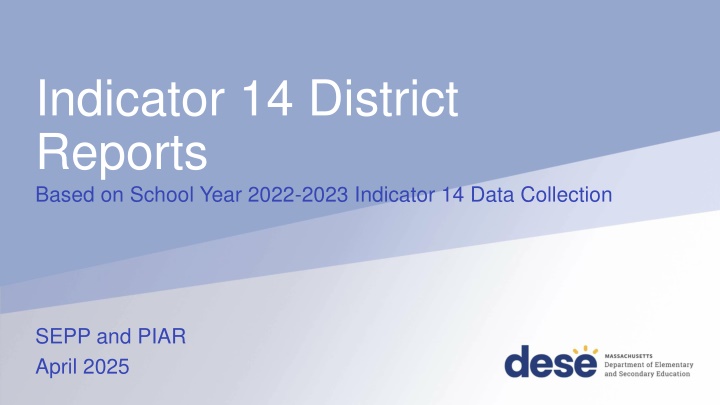
Indicator 14 District Reports for School Year 2022-2023
Explore the detailed reports on Indicator 14 District data collection for the 2022-2023 school year. Learn about engagement types, measurements, calculations, and factors to consider to make informed decisions for high school programs.
Download Presentation

Please find below an Image/Link to download the presentation.
The content on the website is provided AS IS for your information and personal use only. It may not be sold, licensed, or shared on other websites without obtaining consent from the author. If you encounter any issues during the download, it is possible that the publisher has removed the file from their server.
You are allowed to download the files provided on this website for personal or commercial use, subject to the condition that they are used lawfully. All files are the property of their respective owners.
The content on the website is provided AS IS for your information and personal use only. It may not be sold, licensed, or shared on other websites without obtaining consent from the author.
E N D
Presentation Transcript
Indicator 14 District Reports Based on School Year 2022-2023 Indicator 14 Data Collection SEPP and PIAR April 2025 1
Agenda Overview of Indicator 14 Purpose Reports Factors to Consider Overview of the Content Overview of Statewide Data Wrap-up 2
Overview - Measurement Percent of youth who are no longer in secondary school, had IEPs in effect at the time they left school, and within one year of exiting high school were: A. Enrolled in higher education B. Enrolled in higher education or competitively employed C. Enrolled in higher education or in some other postsecondary education or training program or competitively employed or in some other employment 4
Overview - Calculations 3= Other Postsecondary Education or Training 2= Competitive Employment 4=Other Employment Other or Not Engaged 1= Higher Education A B C Total Respondents 5
Purpose Provide districts with: An in-depth view of their exiter data More than just a simple percentage of engagement A tool to do a deep dive into demographic categories across each measurement Question(s) to Consider: How does this data impact programmatic decisions during high school? 6
Factors to Consider Three Main Factors: The Number of Respondents; Your District's Response Rate; and If your Response Group is Demographically Similar to your Exiter Group. District reports are structured to facilitate your focus upon these factors as you consider how Representative your data is. 7
Organization of Reports Page One: Indicator 14 Introduction District and Statewide Engagement Totals represented in pie charts. Introduction to Representativeness Page Two: Table displaying your Exiters demographics compared to Respondents demographics Pages Three and Four: Indicator 14 Engagement across six demographic categories 8
Demographic Groups Gender Ethnicity Exit Type Level of Need Type of Disability Economically Disadvantaged 9
Lets look at todays sample, the statewide report. 10
Page One Report Title Short introduction with link to information about Indicator 14 District Engagement Statewide Engagement Each pie chart includes each measurement in Indicator 14: Higher Education Competitive Employment Other Education Other Employment Not Engaged 11 11
Page One (continued) Reviews the factors to consider: The number of Respondents Your district s Response Rate Introduces Page Two and explains how to determine if your Response Group is demographically similar your Exiter Group 12 12
Page Two Comparison of Exiters and Respondents by: Gender Ethnicity Exit Type 13 13
Page Two Comparison of Exiters and Respondents by: Level of Need Type of Disability 14 14
Page Three Includes a table of Indicator 14 Engagement by demographic groups, by each measurement type: 1 - Higher Ed 2 - Competitive Employment 3 - Other Education 4 - Other Employment E - Total Engagement NE - Not Engaged Start by comparing E and NE for all: Then consider the detail that is provided Let s look at the first Demographic group, Gender 15 15
Page Three Ethnicity: First review the proportion of all for each Ethnic group focusing on groups including larger numbers of respondents Then consider Engagement vs Not Engaged percentages Then consider detail provided under each of the Measures, especially M1 and M2 Exit Type 16 16
Page Four Respondents by Level of Need Respondents by Type of Disability 17 17
Page Four (continued) Type of Disability Economically Disadvantaged: Although overall Engagement is similar for each group, there is great variation in the type of Engagement reported, for example: 1 Higher Education: Yes 26% vs No 47% Considering what you know as educators, what might explain this? 18 18
Contact Information DESE Kristin Castner, Indicator 14 Lead kristin.castner@mass.gov 781-338-3576 PIAR Dr. Patrick Turbett turbetjp@potsdam.edu Robert Shepherd shephers@potsdam.edu 315-267-2718 19






















